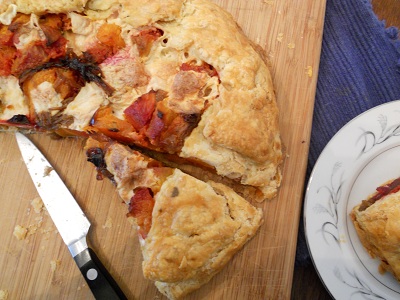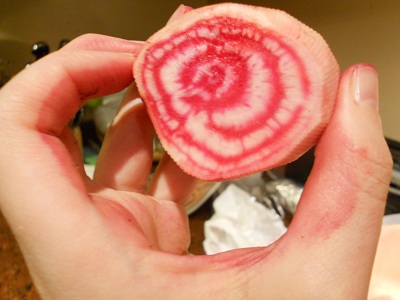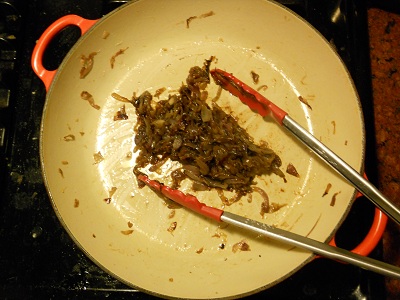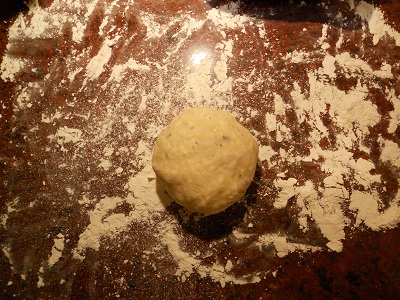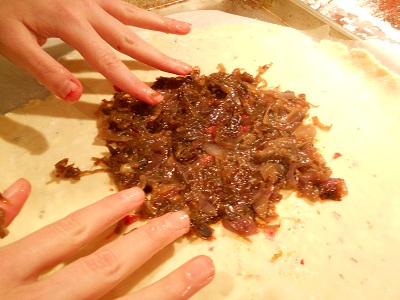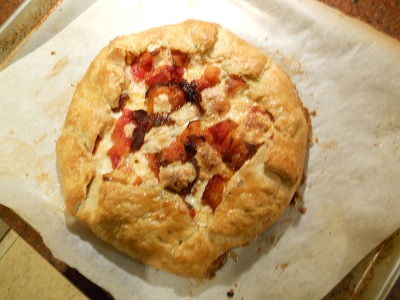One hundred posts in, and I’m still making the same rookie mistake: I haven’t yet learned I need to photograph all my cooking and baking projects, and not just ones I aim to post on this here blog. And what’s even sillier on my part is the fact that I’ll sometimes be dining with other people who do photograph everything they’re about consume, like my friend Rachel who took some really beautiful photographs of every dish of our dinner on Saturday night. (Quick review: extremely affordable, very tasty, and terrible service. I’ll probably be back.)
I think I’ve just committed the most egregious example of this mistake with this savory tart filled with roasted vegetables, caramelized onions and smoked mozzarella. I had no plans to make this, nor blog about it. Nope, had no dreams about how well the sweetness of the onions would bounce off the smoky cheese that had melted in between the layers autumn vegetables that had been wrapped in a savory, flakey crust. Nope, not a thought.
What I had planned on taking a picture of was the butternut squash. Not because I wanted to do anything with it for the blog, but because I wanted to document its size. It was the largest squash I’d ever seen — my guess is one and a half feet high and about 15 pounds. It was roughly as tall as my cat, but clearly outweighed him by five or so pounds. I had wanted to photograph the cat standing next to the squash, but I totally forgot to do it until I had cut off the top of the squash on Sunday night in order to whip together some butternut squash risotto. After I had cleaned and cubed the chunk of squash – there is still a chunk of squash in the fridge that hasn’t been touched, about the size of a regular butternut squash – I realized I had way too much squash on hand. So I decided to roast the leftover squash, and while I was at it, I might as well toss in some other roots I had hanging around my crisper. So out came some beets, a few carrots, and a handful of red potatoes from the cupboard. I did call Rich in at one point to take a photo of the striped Chioggia beet because I was so taken by its beauty. Can you believe this came out of dirt? I asked him.
So I peeled and cubed my root veggies, tossed them altogether in a bowl with a few glugs of olive oil and a healthy pinch (make that two pinches) of salt, and dumped it all in a large lasagna pan. I decided at the last minute to lay down a few sprigs of thyme on top. My goodness, I said to myself, all those colors, it’s as pretty as a picture. I then covered it with foil, and tossed the pan into a 400 degree oven. I know, ridiculous, right? To see it, say it, and then do nothing about it. So silly!
About 20 minutes in, I checked the veggies, gave them a stir, and then 25 minutes after that, I removed the foil, gave everything a stir, turned the oven down to 350, and baked them for about 15 minutes more. I then removed the pan from the oven, admired how all the pinks and oranges looked like a sunset, and then taste-tested a few of the different veggies to make sure they had all softened sufficiently. Once they cooled, I moved them to some Tupperware and put them in the fridge.
This next part is something that I often grapple with on this blog: using ingredients that aren’t exactly inexpensive. Last week I was poking around the cheese case at the market around the block when I stumbled upon a very nice hunk of smoked mozzarella. It was some sort of Manager’s Special that day, and was discounted $3. I bought the cheese – I mean, wouldn’t you? – but figured I wouldn’t mention it on the blog because I couldn’t very well go and expect people to go and buy a pricey bit of cheese for something, even though I bought it at a discount.
So, I was sitting at my desk at work thinking about my ball of cheese and my roasted vegetables when it occurred to me that those two things might taste very good together. But I didn’t want to mash them into a sort of hash and put them in a pie dish and melt the cheese on top. And that’s when it dawned on me: this would be the perfect opportunity to try out a savory version of Jacques Pepin’s apple galette with some fresh herbs added to the dough. And, I asked myself, wouldn’t the tart be so much better if some caramelized onions were involved?
And that’s when I kicked myself for not photographing my roasted root veggie prep. I did not know any of it was going to end up on Cheap Beets, but now it has, if but with a truncated version of the photography. Sure, some of you might take note that this is the third version of some sort of rustic tart on my blog – in a row, no less. Some of you might even call it cheating. But I don’t think you’ll really mind.
Rustic Roasted Root Vegetable Tart with Caramelized Onions and Smoked Mozzarella.
This is four separate recipes in one, just as the roasted pear and cranberry crostata was. I followed my own advice this time and made each part on a different night. Of course, I hadn’t actually planned it that way, but tarts really are what happen to you while you’re busy making other plans.
Part One: Roast approximately three cups of root vegetables – I suggest butternut squash, beets, carrots and potatoes – according to the description above.
Part Two: Make the savory crust
Crust Ingredients
1½ cups all-purpose flour
½ teaspoon salt
1 stick plus 2 tablespoons cold unsalted butter, cut into small pieces
1/3 cup ice water
1 teaspoon fresh sage, ripped into small pieces
1 teaspoon fresh thyme
Directions
In a food processor, combine the flour with the salt, butter and fresh herbs and process for about 5 seconds. Sprinkle the ice water over the flour mixture and process until the pastry just begins to come together, about 10 seconds; you should still be able to see small pieces of butter in it. Transfer the pastry to a work surface, gather it together and pat into a disk. Wrap the pastry in plastic or wax paper and refrigerate until chilled. (You can also roll out the pastry and use it right away.)
Part Three: Caramelizing the onions
Ingredients
3 red onions, cut in half, laid flat, then sliced into ¼ inch thick half moons
Olive oil
Salt
Directions
Place the onions in a deep 4-quart saucepan and drizzle and toss with olive oil to coat, about ¼ cup. Set over medium heat and, shimmying the pan occasionally, cook until the onions are slightly golden on the edges. Stir occasionally – it might take as long as 25 minutes of slow, slow cooking — then stir in a few pinches of salt. Stew, stirring occasionally, until the onions are amber colored and tender but not mushy, another 20 minutes or so. If at any point the onions look as if they may dry out, cover them to trap some of the moisture in the pan. Taste for salt. You should get about 1 cup cooked onions.
Part Four: Assembling the Tart
All of the previous ingredients can be made beforehand and refrigerated for approximately three days.
Ingredients
¾ cup smoked mozzarella, cut into ½ inch pieces
Savory dough
Caramelized onions
Roasted root vegetables
1 egg, lightly beaten
Directions
Preheat the oven to 400°. On a lightly floured work surface, roll out the pastry to a circle and transfer to a large rimmed baking sheet.
In the center of the pastry, lay out all but one quarter of the caramelized onions.
Lay two thirds of the mozzarella on top of the onions.
Using a spoon, gently place all of the root veggies on top of the cheese.
Distribute the remaining onions and pieces of cheese on top of the vegetables.
Fold the pastry edge up and over the vegetables to create a 2-inch border.
Brush the folds of the crust with the beaten egg.
Bake the tart for about 1 hour, until the pastry is nicely browned and crisp. Transfer the pan to a rack and let the tart cool. Serve warm or at room temperature.
